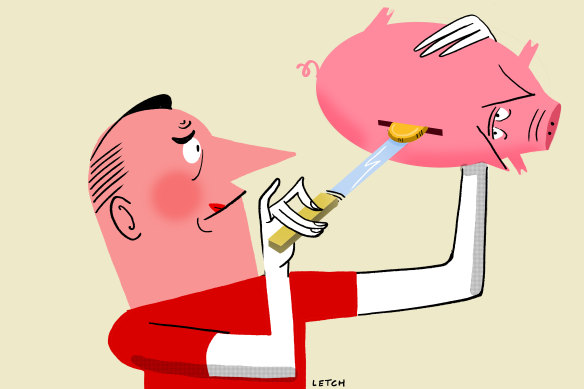Opinion
We are living and spending like it’s 2017 – and not in a good way
Victoria Devine
Money columnistOh, 2017. What a lifetime ago those simpler times feel like. Sophie Monk searched for love on The Bachelorette. Amazon launched Down Under. Donald Trump gave us the term “covfefe”, and Schapelle Corby finally returned to Australia as a free woman 13 years after being arrested in Bali.
I enjoy a walk down memory lane as much as the next person, but the reason for reminiscing on the good old days of life with an iPhone 8 isn’t actually all that good this week. In fact, it’s pretty bloody bad, especially if you’re one of the millions of Australians who are, at best, feeling the economic pinch and, at worst, scraping through our current cost of living hellscape by the skin of your teeth. And that’s because, according to new data from the Organisation for Economic Co-operation and Development, Australians are living and spending like it’s 2017.

Millions of Australians are feeling the economic pinch.Credit: Simon Letch
Released last week, the OECD data found that when compared with 19 other member nations’ economies, Australian households experienced the largest drop in inflation-adjusted disposable income over a two-year period to March 2024.
And, deep breath in here, so great is the dip in our purchasing power that economists are warning it will take a further two years to even recover to pre-pandemic levels, let alone return to financially living as if we’re in this decade. Yep, that’s the promise – or threat, depending on how you see it – of living in 2026 on a 2020 budget.
Australia wasn’t the only country to go backwards during the same two-year period. However, what’s so scary are both the size of the drop, and what it means when compared with other OECD incomes.
Disposable incomes of people living in Czechia, Denmark, Sweden and Canada also all went backwards during the same period, but Australian incomes are higher than in those nations. By OECD standards, Australia is among the top 10 in the world for incomes – coming in at sixth after Luxembourg, the US, Switzerland, Iceland and New Zealand. However, disposable income rates in all those nations grew, as ours went into the red.
So why has Australia seen such a marked drop in the amount of spare money we have while other nations have been flourishing? In news that will shock precisely no one, three of the biggest factors responsible for our 8 per cent fall are record-high mortgage repayments and rental prices, general inflation, and a surge in income taxes.
Data from the Australian Bureau of Statistics backs this up. Its monthly household spending indicator data for July 2024, released this week, shows that spending increased by 0.8 per cent month-on-month, and rose by 2.9 per cent compared with July 2023.
This comes at a time when rents have risen nationally by 15 per cent over the past two years, mortgage holders are spending some of the highest levels on record after interest rates went from 2.4 per cent in March 2022 to 5.1 per cent in 2024, and after years of stagnant wage growth.
What’s more, we’re paying an average of 16.4 per cent in income taxes – among the highest rates on record. The last time we came even close to paying this much was in June 2000, when we averaged 16.1 per cent. In that simpler time of 2017, income tax rates were between 13.6 per cent and 13.9 per cent.

Stage three tax cuts that came in on July 1 have not boost discretionary spending.Credit: iStock
Anyone who has been to the supermarket in the past two years, filled a car with petrol or paid a utility bill knows that everything is costing more. The same goes for the roof over your head, whether you own or rent. Before you know it, the payslip that just hit your bank account has been stretched that little bit further, and what you save for emergencies or to use on discretionary items such as clothing, going out for dinner or seeing a movie becomes smaller and smaller.
The federal government had expected the stage three tax cuts from July 1 would boost discretionary spending asa people had slightly more disposable income to play with (an increase of about 1.5 per cent). The ABS data shows that hasn’t happened just yet.
No doubt, that’s because any reprieve that we are able to enjoy, no matter how nominal, comes at a time when most of us are financially exhausted and wary of what could come next.
For now at least, there is a grain of good news. Despite the pain we’re all feeling, the Australian economy is still growing, slowly but sustained, and the much-talked about and feared potential recession remains at bay.
I don’t know about you, but I need something a little stronger than a covfefe right now to digest all of this.
Victoria Devine is an award-winning retired financial adviser, best-selling author, and host of Australia’s number one finance podcast, She’s on the Money. Victoria is also the founder and co-director of Zella Money.
- Advice given in this article is general in nature and is not intended to influence readers’ decisions about investing or financial products. They should always seek their own professional advice that takes into account their own personal circumstances before making any financial decisions.
Expert tips on how to save, invest and make the most of your money delivered to your inbox every Sunday. Sign up for our Real Money newsletter.